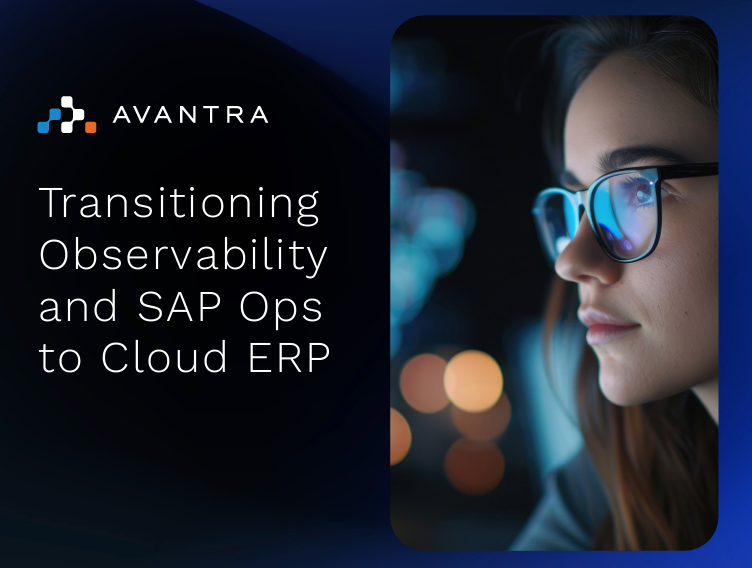5 min read
Tackling the challenges of SAP's hybrid ERP world
By: Heiko Mannherz on Aug 10, 2021 11:00:00 AM

SAP Hybrid ERP Infrastructure presents an opportunity and a challenge at the same time. The Q2 edition of the DSAG-blaupause, the German-speaking SAP User Group’s member magazine, discussed the challenges and opportunities of hybrid scenarios. At Avantra we strongly believe we can help you to overcome some of the challenges.
Find out how Avantra can support your SAP hybrid ERP:
What is SAP hybrid ERP?
Most businesses nowadays are likely to consume at least some services from public or private cloud providers. At the same time, many of those will still have applications running in their own data centers. Some business processes may use cloud resources only, some may run completely on-premises, and some may even run partly in the cloud, partly on prem. This mixture of different application or service components in your own data center and in public or private clouds is what we call a hybrid infrastructure.
For many companies, this may be an intermediate state on a journey into a cloud-only world. As with almost any migration, there is this phase where you need to deal with both, the shiny new solution as well as with the legacy stuff. And more often than not, this phase takes longer than expected.
For other, ardent on premise companies, this situation may just be a necessary evil. A compromise between sticking with their preferred way of running the infrastructure and sticking with their preferred software vendor. Because for many software vendors it seems to be beneficial to provide cloud-only or cloud-first solutions. Including SAP.
Wherever you find yourself in this picture, one thing is for sure: the hybrid world is the reality we live in, and it will remain like this at least for the next couple of years.
What are the hybrid infrastructure opportunities?
The opportunities are clearly to combine the best of the two worlds, as the quoted DSAG article already states in its headline.
Many IT services today are just a commodity. Email, for instance, is such a commodity. Almost no one will run their own mail server for private purposes. We’re so used to Gmail, Hotmail, and the likes that it is hard to believe companies go to the trouble of running their own Exchange servers. I configured mail servers 30 years ago manually. And believe me, it is something you just don’t want to do. Other common examples of what became commodities include Customer Resource Management or HR systems. For many businesses, these will be the first things to consider moving to the cloud.
Cloud services allow you to quickly innovate. You can try new solutions without upfront investments into new technologies. This only brings you into a comfortable position to experiment without being doomed to succeed. Try, fail, try again, fail better. These learnings from failures are a vital step on the innovation journey.
Learn more about cloud challenges >>>>
Flexibility is another great example of the benefits you gain from cloud services. More often than not this is organizational flexibility. You don’t need to coordinate your activities, in particular the ones related to innovation, with your network team, the server team, the database team, the security department, and so on. The bigger the organization, the more you probably gain by just being able to do things, rather than having countless coordination meetings.
On the other hand, on-premise solutions are still the preferred way to go when you need low latency solutions, in particular when you control manufacturing or logistics. Not every location in the world is in close proximity to the cloud providers’ data centers. But that might just be the place where your factory happens to be.
However, storage or processing of sensitive data may be the most important reason to stick with on-premise solutions. Whether it’s your intellectual property you want to protect, or personal data you have to protect, in many cases on-premise is the safest bet.
What are the hybrid infrastructure challenges?
Obviously, the complexity of your IT landscape and its operation increases if you do both, cloud and on-premise. It’s quite obvious there is more and different technology involved that requires more and different knowledge. And there are simply more connections between components. All this increases the overall complexity.
Other challenges may be less obvious. Cloud solutions have a significantly shorter release cycle. And hence a shorter upgrade cycle. Your cloud solution is likely to be updated once a quarter, whereas for your on-premise ERP systems you probably schedule upgrades only every two or three years. If you have dependencies between the different solutions, the speedy cloud upgrade cycles may force you to more frequently upgrade on-premise. Combine this with the way you manage custom code and you face an even bigger challenge.
Can you overcome this challenge? One option is to follow your preferred software vendor and rise to the cloud with what you thought should remain on-premise. Or you start automating your on-premise operation.
What struck me most in the DSAG article is that monitoring of hybrid landscapes is considered a challenge. The only possible explanation is that these customers really only look at solutions SAP provides.
Automating SAP operations
The other challenge is a tougher one. While monitoring SAP landscapes is relatively easy, automating SAP operations is hard. However, we are convinced this kind of automation is absolutely necessary to overcome the real challenges, which are somewhat hidden in what the DSAG article states. Be it more frequent upgrades of on-premise SAP systems, or moving more SAP workloads from on-premise to the cloud: both require a significant amount of SAP experts in the upcoming years. And according to our research, it requires more SAP experts than available on the market. So, even if your answer to the frequent upgrade challenge is to move more workloads to the cloud, you need to start automating now. Otherwise, you won’t succeed in your migration projects, because your SAP experts are busy doing operations work.
How can Avantra help?
For almost twenty years Avantra proves that monitoring SAP landscape does not have to be cumbersome. And for a couple of years now this extends to both, on-premise and cloud solutions. Avantra provides a single-looking glass to your whole SAP landscape, be it on-premise, off-premise, or both.
Avantra is the industry-leading AIOps platform that simplifies SAP operations. With unmatched levels of intelligence and insight, Avantra gives SAP Operations teams freedom from monotonous tasks. It anticipates issues across the entire SAP landscape well before they become a problem, making Avantra the go-to automation platform for many of the world’s largest enterprises and managed service providers. Avantra is a Basis team’s trusted guardian, bringing control, proactivity, and simplicity to some of the even most complex SAP landscapes.
Even to your hybrid one.
Find out how Avantra can support your SAP hybrid ERP:
Related Posts
SAP in manufacturing for increased productivity | Avantra
As the landscape continues to become more challenging, it's safe to say automation is the future of...
What is an SAP automation platform? The Pinewood Derby story
My son, currently nine years old, is an active Cub Scout and we’re coming up on one of the most...
AIOps for SAP: From Ground to Cloud
Anyone working in the SAP market in 2025 is aware of two big topics: migration to cloud-based ERP...




